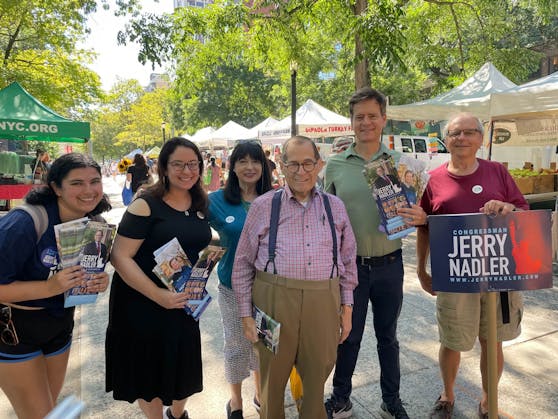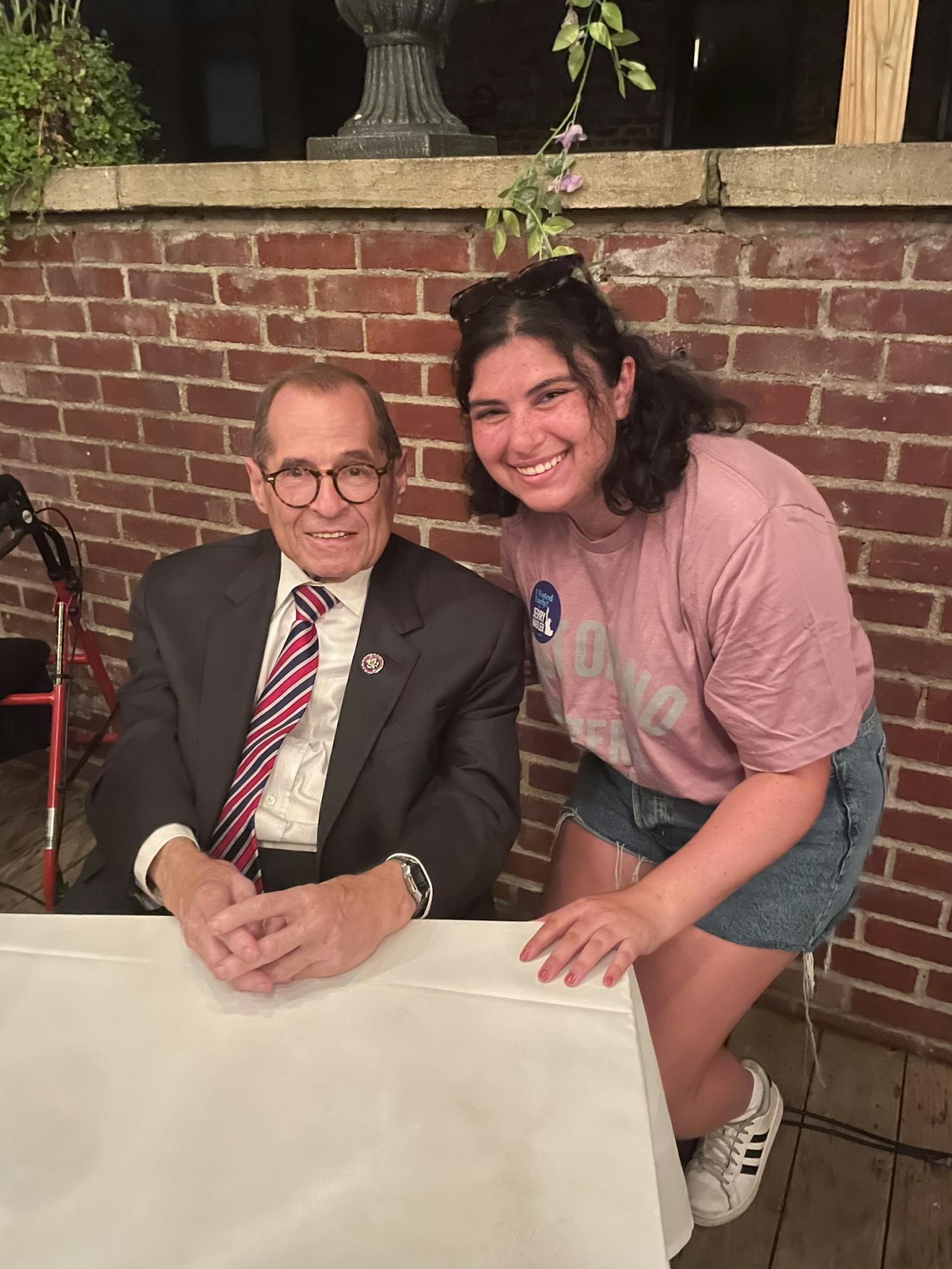At home on the campaign trail
Rachel Landis ’23 spent the summer working as a campaign staffer in one of this year’s most intense primary races. She didn’t have to leave her neighborhood to do it.
Like many New Yorkers, Rachel Landis ’23 could be found at her local voting booth on August 23, this year’s primary election day in the state. But Landis wasn’t there to cast her ballot. She had voted early because she knew she’d be busy on Election Day.
Landis spent the evening working at the polling place. When the polls closed at 9 pm, Landis walked to her office, Rep. Jerrold Nadler’s campaign headquarters.
There, she joined her fellow campaign staffers to watch the results roll in. The numbers already looked too good to be true. She was at headquarters for less than twenty minutes when the race was called for Rep. Nadler by CBS and NY1. She and other campaign staffers headed to a nearby restaurant for what was now a victory party.
Soon after they arrived, the race was called by The New York Times and the Associated Press. Everyone hugged and congratulated one another. When the dust settled, Nadler won nearly 56% of the vote, Rep. Carolyn Maloney had 24%, and Suraj Patel had 19%.
Landis was thrilled about the hard-fought victory. At the start of the race, Nadler was behind in the polls, she said, and it felt good to see the hard work she and her team put in over the past few months pay off.
Landis spent the summer working for Nadler’s campaign. As part of the field team, she called voters, knocked on doors, and handed out campaign fliers on the street. Much of her day was spent talking to voters about the upcoming election. Working on this campaign, Landis found herself on the front lines of what CNN called “one of the nastiest primary races of the year.” It’s also one she is closely connected to. Landis is a lifelong resident of Manhattan’s Upper West Side, which Nadler has represented in the House of Representatives for three decades. “I’m a lifetime Jerry fan,” Landis said.
So far, Landis has worked on four campaigns and knew she wanted to continue working on the field side. At the start of the summer, she texted a friend on Nadler’s campaign staff about being a part of the team. She sent in her resume and was hired soon after. She also had summer job offers from a non-profit and a Senate office, but working on the Nadler campaign was an opportunity she couldn’t pass up.

This year, the biggest threat to Nadler keeping his seat in the House came from an unlikely source: longtime colleague Rep. Carolyn Maloney, who was first elected to the House of Representatives in 1993, within six months of Nadler. She even represented the neighboring district to Nadler’s, which included the Upper East Side neighborhood.
This year, a redrawn congressional map thrust the longtime political allies into a rancorous race against each other. The process of redrawing New York’s congressional districts began in 2021 following the release of the 2020 United States Census results. It didn’t go smoothly. A tumultuous legal battle between the State Legislature and Republican party lasted nearly a year. The result was a controversial reshuffling of New York’s congressional map.
One of the most significant changes was the combining of the Upper West Side and Upper East Side neighborhoods into a single district. The new maps upset many New York Democrats, including Nadler and Maloney. Both ultimately decided they would run against one another in hopes of continuing to represent their own neighborhoods, rather than run in a different district.
The bitter political battle between Nadler and Maloney received national media attention in the months leading up to the primary. The candidates took shots at the others’ voting history. Maloney questioned Nadler’s ability to finish out another term in office and his mental fitness. The race turned the friends into political enemies and forced Democrats in the new 12th District to decide between two established progressives who had represented their city for decades.
In terms of policy, the two candidates agreed on most things. The starkest differences came from historical disagreements over 9/11 and its legacy. Landis pointed out three key differences between them: Nadler voted against invading Iraq, against the PATRIOT Act, and for the Iran nuclear deal. Maloney voted in the opposite on all three counts. Landis said that these issues were still contentious because it showed that being a progressive might mean different things to different people. Landis said the primary asked voters, “What kind of a Democrat do you want representing you? What direction do you want the party to go?”
For Landis, the choice was easy. Like Nadler, she considers herself a “principled progressive,” and said that Nadler stands out to her among progressive political figures from his generation because he has supported progressive causes, such as climate action and workers’ protections, since the start of his career.
One issue that voters in her district were particularly passionate about was abortion access.
She started working on the campaign around the time the Supreme Court overturned decades of legal precedent that protected the right to abortion for all Americans with its ruling in Dobbs v. Jackson Women's Health Organization. “The leaked Dobbs decision played a huge role in this race,” Landis said.
Abortion access is an issue that Landis cares about deeply. She plans to go into reproductive rights policy work after graduating. In 2004, Nadler sponsored a bill which would have codified the right to access abortion care nationwide. “He knew that we needed more than a Supreme Court case to protect the right to choose,” Landis said. Landis elaborated that in her view, Nadler’s history on the issue made him the better candidate for women.
Landis said other big dynamics in the race were crime and inflation. On August 12, Congress passed the Inflation Reduction Act — an omnibus bill with actions on healthcare, climate, and taxes. Landis said this helped energize voters in the week leading up to the election. “I think it really excited voters, more than anything else, just to be like, ‘Oh, Democrats can do something!’” Landis said. In the week following its passing — which was also the final week leading up to the New York primary — Landis said more undecided voters came to talk to her about the upcoming election and seemed excited about voting for a progressive Democrat.
All candidates in the 12th district race used parts of their identity to appeal to voters. Suraj Patel, an Indian-American and a millennial, talked about the need for a generational change in leadership and emphasized the importance of having more Asian-Americans in Congress. The race also pit New York’s only incumbent Jewish congressperson against one of the only women representing the state in Congress.
Landis recalled what one Jewish woman voter said about how she made her decision: “She told me, ‘I got into the ballot box and I weighed my identity as a woman and my identity as a Jew, and Jew won out.’” Landis is a Jewish woman, too. But she said she didn’t share this woman’s experience. She never felt she had to choose between her identities to decide which candidate to support.
Landis said as an intersectional feminist, she believes just because someone is a woman does not mean they are automatically the best person to represent her in Congress. “I'm very proud to be a woman. I'm very proud to be Jewish. I'm very proud to be a Jewish woman. And I don't feel like this race made me choose a side of myself so much as it made me say, ‘As a Jewish woman, what is it that I care about? And who is it that I feel cares about those things as much as I do?’ And for me, that answer was Rep. Nadler.”

Landis has spent plenty of time in class studying political science and is writing a senior thesis in politics. She said doing working on the ground in politics is very different from talking about it in class. She described Brandeis as a “bubble,” and working on a campaign as “outside the bubble.” “I like being outside the bubble because it gives context to everything,” Landis said.
She said she can talk for hours in class about big picture issues like national climate legislation, but doing real campaign work reveals a crucial side of politics that can’t be replicated in a classroom.
“It’s so different to talk about it with people who see it as politics than with people who see a single issue that’s affecting their everyday life,” she explained.
Working for the Nadler campaign, Landis was frequently asked about small-scale issues that directly affect voters' day-to-day lives. People would say things like, “Well, my subway station was flooded the last time we had a flash flood, and I couldn't get to work for a week. What’s Jerry [Nadler] gonna do about that?”
Having grown up on the Upper West Side, Landis is no stranger to everyday issues affecting the lives of the voters in her district. “Floodwater is literally the worst water — like, that's how you get all the diseases. … Make sure to quote me: Do not step in floodwater. Ever.” Flood water aside, Landis is excited to keep doing the dirty work of politics.



Please note All comments are eligible for publication in The Justice.